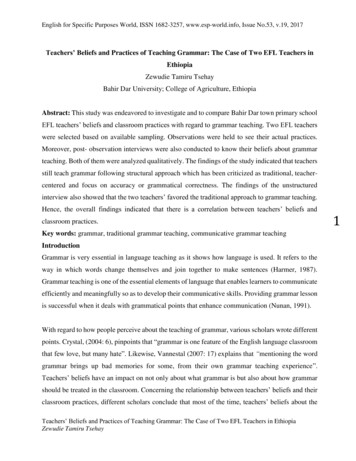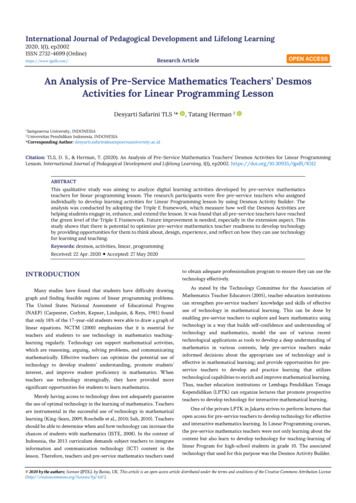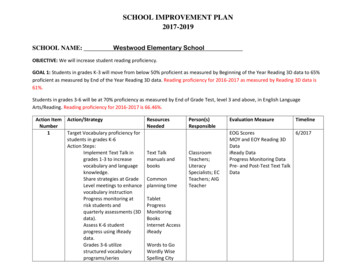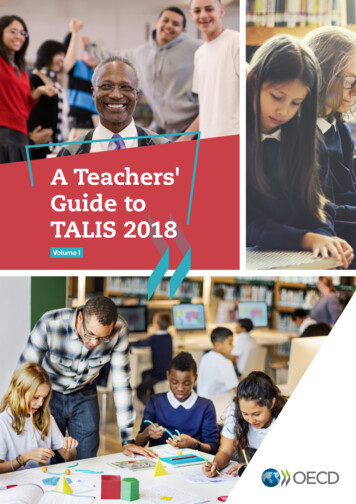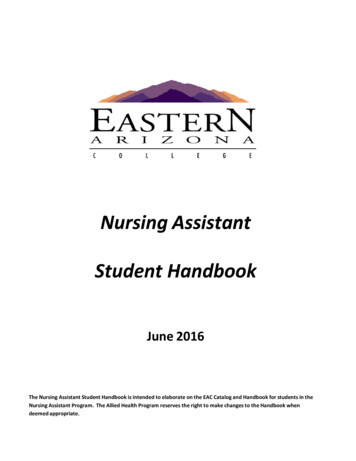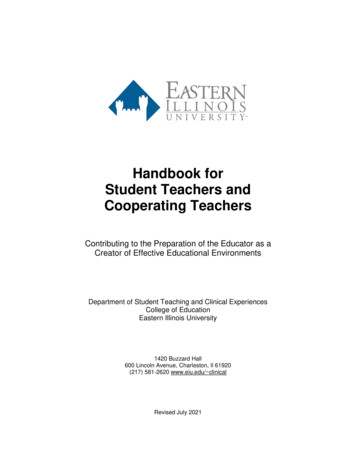
Transcription
Handbook forStudent Teachers andCooperating TeachersContributing to the Preparation of the Educator as aCreator of Effective Educational EnvironmentsDepartment of Student Teaching and Clinical ExperiencesCollege of EducationEastern Illinois University1420 Buzzard Hall600 Lincoln Avenue, Charleston, Il 61920(217) 581-2620 www.eiu.edu/ clinicalRevised July 2021
2Table of Contents3 Introduction to the Conceptual Framework4 Eastern Illinois University and Collaboration with the Public Schools in Education5 The Cooperating Teacher Requirements for Being a Cooperating TeacherThe Role of the CooperatingAssumption of Responsibility by the Student TeacherPlanningObserving the Student Teacher and Providing FeedbackWorking with Student Teachers when Challenges AriseStudent Teacher Evaluations11 The Student Teacher Preliminary Visit to Student Teaching SiteCourse Work, Employment, and Coaching During Student TeachingAttendanceProfessionalismDress and AppearanceGeneral Courtesy and Interpersonal RelationshipsConfidentialityE-Portfolio Submissions and edTPASeminarsStudent Teaching 4000 (STG 4000)Substitute TeachingApplication for Teaching LicensurePublic School Work Stoppage PolicyTermination of PlacementThe University Student Teaching Coordinator & the Student TeacherCooperating Teachers’ Expectations for Student TeachersExit Level Competencies for Student TeachersDispositions for Teaching18 The University Student Teaching Coordinator19 Student Teaching Activities The Teaching ScheduleClassroom Management and Discipline PlanLesson PlansJournalsParent ContactWorking with Diverse PopulationsObservationsStudent Teaching 4000 (STG 4000)22 Appendices A – Outside Employment Verification FormB – Teaching ScheduleC – Student Teaching Evaluation Rubric (Mid-term)D – Student Teaching Evaluation Rubric (Final
3Introduction to the Conceptual FrameworkEducator as Creator of Effective Educational Environments:Integrating Students, Subjects, Strategies, and SocietiesA conceptual framework serves to establish the shared vision for all efforts in preparing educators to work in P-12 schools byproviding direction for programs, courses, teaching, candidate performance, scholarship, service, and unit accountability. Itis a dynamic document that is articulated, shared, coherent, and consistent with the institutional mission.Eastern Illinois University has a long and respected history of providing exemplary programs for teacher preparation. Faculty,staff, and public-school partners are committed to the preparation of professionals in the design and implantation of programsthat advance intellectual, physical, psychological, and social well-being. A brief explanation of the primary ConceptualFramework around which all professional preparation is designed is contained within this section.The Conceptual Framework at Eastern Illinois University is “Educator as Creator of Effective EducationalEnvironments: Integrating Students, Subjects, Strategies and Societies”. Underlying this framework is the conviction thatprograms must be well-grounded in general education, subject area concentrations, and allied subject matter. Additionally, allprograms induct teacher candidates into the profession through sequenced coursework and experiences designed to develop arobust knowledge base, skills in content delivery and diverse instructional strategies, and positive dispositions for teaching.The Educator: As a creator of effective educational environments suggests a learned set of behaviors requiring an extensiveknowledge base and preparation Must be an effective decision maker Creates environments conducive to learning Possesses higher level thinking skills to create effective environments Is committed to life-long learning Develops a personal approach to the profession, keeping in mind individual identity and integrity while guided bytenets of pedagogy and concepts of diversity Understands the distinction between the science and the art of the profession Reflects, respects, and understands the diversity of students, subjects, strategies, and societiesThe overall theme of “educator as creator of effective educational environments” provides a focus to the five domains that inturn provides a scaffold for the structure, coherence, and continuity of the unit programs.In creating an effective educational environment, all educators must: establish environments for positive development oflearners; demonstrate professional knowledge and skills; establish environments for academic achievement; and respond tothe school and community. Educators must have knowledge of students, subject areas and levels, strategies, technologies,and the diversity of societies and communities to prepare effective educational environments. The theme allows the educatorto develop skills and knowledge in the areas of the five domains (in no rank order): Diverse students Diverse strategies Diverse subjects and levels Diverse societies and communities Diverse technologies
4Eastern Illinois University and CollaborationWith the Public Schools in EducationThe College of Education works closely with professional colleagues in the public schools to ensure that partnerships aremutually beneficial and include shared responsibility for clinical preparation and continuous improvement of candidatepreparation. In accordance with CAEP Standard 2.1 this includes but is not limited to setting mutually agreed uponexpectations for candidate entry, preparation, and exit; ensuring that theory and practice are linked; maintaining coherenceacross all aspects of the teacher education program; and sharing accountability for candidate outcomes. Through thesepartnerships superior clinical experiences are provided to all university students preparing to become teachers. Inaccordance with CAEP Standard 2.3 these partnerships assure that clinical experiences are of sufficient depth, breadth,diversity, coherence, and duration to ensure that all candidates can demonstrate their developing effectiveness and positiveimpact on all students’ learning and development.The most promising sites for prospective teachers are schools that promote high levels of learning for all students andcontinued learning and professional development for teachers.As diverse as the public partners may be, all sites: Promote high levels of learning for all students Serve as learning sites for university students preparing to become teachers Support continuing professional growth for teachers Encourage collaborative school-university research and inquiry about teaching and learning
5The Cooperating TeacherThe College and its partner districts work together to select cooperating teachers who have demonstrated a positive impact onP-12 learning and the ability to help the student teacher grow and develop (CAEP Standard 2.2). A teacher who agrees tosupervise a student teacher has consented to assume one of the most responsible, influential, and exciting positions in teachereducation. This brief period in the life of a college student has greater impact on professional skills and potential than anyother part of a college career. It is a stimulating experience for a teacher to have a student teacher in the classroom becausepupils seem to learn more when a student teacher is available to work with a class. Despite the increased responsibilityinvolved, the experience of student teaching is a winning proposition for all parties.The period of student teaching is a time in which the cooperating teacher will have to be prepared to make modifications inorder to accommodate a new personality in the classroom. This time offers a unique opportunity for the cooperating teacherto model various teaching styles, along with guiding planning, preparation, teaching, evaluations, assessments, andappropriate interactions.A teacher who has been solely in charge of a class will be working collaboratively and cooperatively with a person who is acapable, but less experienced instructor. The information included in this handbook is presented to assist in this collaborativeeffort. The cooperating teacher’s portion of the book provides information specific to the expected roles and responsibilitiesof the cooperating teacher. The student teacher’s portion will aid the cooperating teacher in understanding the expectationsthat the university has for the student teaching experience.Requirements for Being a Cooperating TeacherEastern Illinois University has established the following requirements for classroom teachers to qualify them as cooperatingteachers: Possess a sincere desire to work with a student teacher and share her/his classroom Possess personal qualities that are essential to good supervision such as practical insight into interpersonalrelationships, understanding of social class structure, and a wide cultural background Possess a license which provides that the teacher is fully qualified for the subjects, age range, and setting in whichshe/he is assigned to teach. This may include endorsements in specific age levels or content areas Have completed a minimum of three years of successful teaching experience Should have earned a master's degree or the equivalent and/or is highly recommended by a building administrator Possess and exhibit a genuine professional interest to improve teaching through further college or university studyand participation in activities having a direct relationship to the field, such as travel or related work experience Be professionally enthusiastic and continue to strive to be an exemplary model for the teaching professionThe Role of the Cooperating TeacherAlthough each situation has unique attributes, basic expectations of supervision by the cooperating teacher are helpful inorder that the university coordinator, the cooperating teacher, and the student teacher work together with clarity and goaldirection. The cooperating teacher is the daily role model for the student teacher in training.The cooperating teacher provides solid examples of how to: Plan thoroughly and creatively for individual and group needs Design and utilize a variety of teaching strategies Include opportunities for diverse learning styles Plan and implement a developmental cognitive and effective program Plan and implement a daily schedule of activities related to cognitive and effective goals
6 Design stimulating classroom environments Assess the growth and learning of each individualSchedule daily contact with the student teacher. Review lesson/activity plans Analyze instructional delivery Discuss progress Brainstorm for new ideas and methods to utilize in working with children Discuss topics, including: long range planning unit planning philosophy of education group communication skills classroom management observational strategies working with parents meeting diverse student needs your expectations building policies evaluation of student learning managerial componentsSchedule extended conferences with the student teacher to discuss: Instructional delivery Unit/lesson planning and implementation Strengths and specific deficienciesCommunicate immediately with the university coordinator if: The student teacher appears deficient in ability, responsibility, or maturity in her/his teaching performance You have questions about policy, procedure, or responsibilities Other areas of concern materializeContinually expect the student teacher to assume a greater share of the planning and direct teaching responsibilities startingfrom the very first day of the student teaching assignment.Assumption of Responsibility by the Student TeacherThe EIU student teacher has had multiple experiences in the classroom and working with students prior to beginning thestudent teaching experience. Most student teachers are confident and anxious to become active participants in the classroom.It is important for them to assume some responsibilities working with students from the first day of the experience.Student teachers must observe their cooperating teachers.
7 Directed observation is best Determine what methods and strategies best promote student learning and engagementStudent teachers should begin working with students on the first day. Give a spelling pretest or test, work with a small group or with an individual on a specific task Circulate about the room and assist individuals who have questions Take attendance, pass out papers, or tally lunch count to help learn students’ names and classroom routinesAdd responsibilities gradually; suggested sequence: Student teacher plans for one subject or class and assumes teaching responsibility by week two Add one subject or class period per week, allowing for the development of planning, reflection of effectiveness ofplanning, and development of classroom management skillsThe goal is full teaching responsibility for the majority of the student teaching placement. If a student teacher does notexhibit a level of performance that makes this feasible, confer with the university coordinator to arrange an alternativeschedule.PlanningCooperative planning elevates the student teacher’s status to that of a partner in the teaching process, provides addedconfidence and security for teaching success and clarifies objectives as student teachers develop skills for planning. Studentteachers need to know what they are trying to do, and why they are doing it. They must accept a major share of theresponsibility for their professional growth as they work toward becoming the independent planner of future lessons.Student teachers must have lesson plans available for review at all times and be submitted in advance to the cooperatingteacher for approval.All lesson plans should be in a complete format. Students may reference their individual department lesson plan template.Planning in and teaching from the Teacher’s Weekly Planner is unacceptable.Planning must: Include long-range plans – how does this lesson fit into the big picture? Be done sufficiently in advance of teaching to allow cooperating teacher time to review Include differentiated instructional practices Demonstrate alternative methods of planning Help create a system which can be used in the futureRegardless of form and length of plan, the basic elements of a plan should include: Goals and objectives Content and procedure Assessment or evaluationRemember: A student teacher needs to understand that good planning facilitates good teaching A well-developed lesson plan may be a student teacher’s best teaching aid
8 When planning, emphasis on results should prevail over emphasis on formatObserving the Student Teacher and Providing FeedbackObservation of the student teacher is essential for analyzing and evaluating her/his performance. The cooperating teachershould provide an atmosphere in the classroom that allows the student teacher to feel comfortable while being observed.Accomplish this by observing on a regular basis, showing positive reinforcement through facial expressions, refraining frominterrupting, inviting the student teacher to observe the cooperating teacher, and following the observation with writtenand/or verbal feedback that emphasizes suggestions for growth.The cooperating teacher is expected to be present in the classroom during the first weeks of the student teaching experience.Daily observations and feedback are important. As the student teacher assumes more responsibility for the classroom, thecooperating teacher should continue to observe and provide feedback. Observations may be an entire lesson, the beginningof class, the end of class, or intermittently during the lesson period.Observations may be structured or non-structured in format. Many observation instruments exist which may assist thecooperating teacher in identifying areas of teaching that need to be addressed. The university coordinator can assist thecooperating teacher in identifying these instruments. Note taking or “scripting” is an unstructured means of identifying whatis going on in the classroom and is useful in providing specific feedback to the student teacher.Quality feedback is essential to the growth of the student teacher. Feedback should be provided on a regular basis andaddress both strengths and areas of concern. Identify successes as well as areas for improvement. Feedback may be writtenor verbal. Discuss written feedback during supervisory conferences.The cooperating teacher should schedule regular conferences with the student teacher. Though communication takes placedaily, it is important to ensure that communication centering on teaching performance is occurring. Weekly conferences aresuggested as they provide both the cooperating teacher and the student teacher opportunities for input and feedback.Remember: "The greatest good you can do for another is not just to share your riches but to reveal to him his own."(Benjamin Disraeli)Working with Student Teachers When Challenges AriseIt is normal to have a few ‘rocky’ days with a student teacher, but if there seem to be ongoing concerns, please contact theUniversity Coordinator. After a student teacher begins her/his assignment, problems may begin to develop.Indicators of challenge include, but are not limited to: Poor interpersonal skills Poor attendance Frequent illness Complaining Blaming Limited concentration Failure to follow through with responsibilities Resistance to suggestions for change or improvement Changes in grooming or appearance Avoiding communication with students, the cooperating teacher, and/or other building staffAs stated above, contact the University Coordinator for assistance.
9Develop a Growth Plan: State the problem(s) Give specific behavioral expectations related to the problem Have student teacher sign growth planFollow up: Document all situations, instances, happenings, feelings, and inappropriate verbal and non-verbal behaviors relatedto the problem(s) identified in the growth plan Provide written feedback to the student teacher Have frequent conferences with the student teacher to review written feedback and progress on the growth plan Keep the university coordinator informed of progressThe University Coordinator is available to you and your student teacher to develop action plans, facilitate discussion, andassist in reaching a positive solution for all involved. If a student is experiencing significant difficulty, and intervention hasnot been successful, the University Coordinator will inform you of the options available to the student. Removal from thestudent teaching placement may be considered.Student Teacher EvaluationsThe cooperating teacher should formally evaluate the student teacher at least twice during the assignment period (mid-termand final).The evaluation instrument is available on the USB flash drive, online at www.eiu.edu/ clinical and is included in thishandbook (see Appendix).Review both the mid-term and the final evaluations with the student teacher, identifying both areas of strength and needingimprovement.The University Coordinator will collect both the mid-term and the final evaluation.Student teaching grades are credit/no credit. It is the university coordinator’s responsibility to assign grades. Thecooperating teacher should recommend to the university coordinator which of these options she/he feels the student teachershould receive as a final grade on her/his transcript.Cooperating Teachers should write either a letter of reference or narrative (on school letterhead) as part of the finalevaluation. Please provide a copy of this letter to the student teacher along with their final evaluation. The UniversityCoordinator will collect a copy with the final evaluation.Topics that may be included are below: Classroom setting –Grade level(s), courses, population of the school and community if especially relevant Special skills and competencies – Note especially those things the student teacher did well or added to the classroom Classroom management - Describe the student teacher’s ability to establish rapport with pupils and the effectivenessand development of her/his classroom management skills Areas needing improvement (optional) - Describe any areas of concern. Reflect on the student teacher’s ability tocorrect said areas and offer a prediction of the student teacher’s success in achieving this correction Character and personality - Describe any professional characteristics that might make this student a good beginningteacher (reflective, personable, dedicated, responsible, hard-working, conscientious, energetic, intelligent, open toconstructive feedback, good natured, maintains a professional appearance, etc.). Discuss how the student teacherinteracted with you, other faculty, administration, staff, and parents
10 Prediction for success - Give a professional opinion as to the probable success of this student teacher based onpersonal growth and professional development shown throughout the student teaching experienceCooperating Teacher CPDHs or EIU Graduate Tuition WaiversContinuing Professional Development HoursIt is our goal for the experience of hosting an EIU student teacher to help you increase your knowledge and skills relative tocollaboration and reflection so as to improve student learning. Based on this effort, we are able to offer you ContinuingProfessional Development hours (30 hours for hosting full-time for 80 Days, 15 hours for hosting a student teacher in asplit or shared assignment)Tuition WaiversWe are glad to offer EIU Graduate Tuition Waivers to teachers who host EIU Student Teachers. Cooperating teachers mayreceive 3 hours of graduate tuition waivers for hosting a student teacher full-time for 80 Days (2 hours ofgraduate tuition waivers for hosting a student teacher in a split or shared assignment). If you wish to receive thesegraduate tuition waivers, we ask that you fill out the online form at www.eiu.edu/ clinical/stipend.php.
11The Student TeacherMany teachers identify the student teaching experience as the most important part of their initial preparation. It is a time ofexciting challenges, intense reflection, and exhilarating rewards. Student teaching is the capstone experience, whereknowledge, skills and dispositions come together and are implemented over an extended period in a consistent setting.This section contains vital information about behavior, policy, and expectations for all student teachers.Preliminary Visit to the Student Teaching SiteYou must make a preliminary visit to your assigned school. As soon as you receive your potential placement, contact theschool and set up a time convenient for the cooperating teacher to make a visit. The major purposes of this visit are to meetthe principal and the supervising teacher, confirm assignment dates, plan, and discuss subjects that will be taught, and getacquainted with the school and community. Treat this visit as a job interview, for a school may opt not to accept you basedupon the impression you make.Your dress and appearance should be professional. Many schools like having student teachers because they can have firsthand knowledge of a prospective employee. The first impressions may solidify or eliminate one as a candidate for a position.Two extremes to avoid are coming across as timid, weak, shy, or too soft spoken, and coming across as an egotistical,overbearing, know it all who talks too much and too loudly. It is better to show that one is competent through teachingperformance than by telling people. One should smile, be friendly, courteous, and come across as willing to learn and willingto work.The following list provides some direction as to the types of information to collect and/or questions to ask on yourpreliminary visit. Make notes of the names of the principal, cooperating teacher, office personnel, and others you meet during yourvisit Become acquainted with the school facilities and the classroom Find out where you may park and obtain any necessary parking permit Obtain a school calendar Obtain a schedule for the school day Obtain faculty and student handbooks or outlines of school rules and policies (if available) Determine the guidelines for dress and appearance Discuss curriculum in class(es) to be taught Obtain copies of textbooks/curricular resources (as available) Discuss expectations for participation in extracurricular activities and the total school program Observe the cooperating teacher’s class(es) if possible Establish a procedure for informing your cooperating teacher of an anticipated or emergency absenceThe university coordinator may have additional guidelines for you. Follow these and report the visit to the universitycoordinator in the designated manner.Course Work, Employment, and Coaching During Student TeachingStudent teaching is a full-time commitment. Students are not allowed to take additional (non-student teaching) course workand working during student teaching is strongly discouraged.
12Taking additional coursework during the student teaching semester is not allowed. Students who wish to take any othercourse through EIU during the student teaching semester must receive a waiver from the Academic Waiver AppealsCommittee (AWAC). Contact your Academic Advisor immediately if you have questions about this.Working during student teaching is strongly discouraged. This is especially important during the first eight to nine weekswhen working on the edTPA. Many teaching activities and responsibilities occur outside the regular school schedule, and thestudent teacher should participate in the total school program. The demands of teaching require an alert, rested, and wellprepared individual who is not dividing her/his energies between teaching and other responsibilities. At no time is a studentteacher allowed to miss student teaching (including after school activities) in order to work at an outside job. If a studentdecides to work and that work is deemed to interfere with the student teaching experience, as determined by the studentteacher’s cooperating teacher, the University Coordinator and/or school administrator, the student will be required todiscontinue working or withdraw from student teaching. Use the Outside Employment Verification Form (see Appendix A)to report outside employment.Coaching during student teaching is a wonderful opportunity but it must be limited to the district at which you are studentteaching. Furthermore, unless explicitly part of your student teaching experience, you may not miss time in your classroomfor any coaching obligations. Any exceptions must be approved by your cooperating teacher and your Student TeachingCoordinator.AttendanceStudent Teaching Coordinators in consultation with your student teaching district will set your beginning and ending day ofstudent teaching. These dates are set around the calendar of the school where you will student teach and often begin prior tothe start of EIU’s semester. During the student teaching semester, candidates follow the calendar of the district where theyare placed.The student teacher’s regular assignment will seldom go beyond the Friday of EIU’s Final Exam week.If students go beyond the Friday of Eastern Illinois University’s Final Exam week, a grade of “Incomplete” is assigned in thecourse(s) until all requirements are fulfilled.The student teacher should be in school every day for the full term of the assignment- 80 Days.Seminar dates and one edTPA submission day count towards the 80-day requirement.Student teachers are allowed one sick day and one interview day without the need to be made up.School closings due to inclement weather will not count towards the 80 Days.When necessary the Associate Dean of the College of Education may be called on to resolve attendance problems.Student teachers are expected to report daily to their assigned locations, or to notify the cooperating teacher and theuniversity coordinator in advance, if she/he cannot be present because of an emergency.The student teacher should report at the same time as the cooperating teacher and should remain at the school site until thecooperating teacher leaves or an agreed upon time.Participation is expected of student teachers in all activities that are required of their cooperating teachers (e.g., P/Tconferences, SIP Days, family nights, etc.)You are required to complete the entire 80 days of the student teaching experience and submit the 80 Day Attendance Log toyour CoordinatorTimes of inclement weather and emergency school closings are announced on the radio and/or through a school districtnotification system. Ask the cooperating teacher about how staff are notified of changes in school calendar due to emergency.
13ProfessionalismStudent teaching places you in the role of a teacher; conducting yourself in a professional manner is therefore essential.Dress and appearance, general courtesy, respecting others, and confidentiality are all parts of being professional.Dress and AppearanceIn matters of dress in the classroom, all student teachers must abide by the guidelines and standards set by the school systemand specific school to which they are assigned. Each student teacher has an obligation to become informed at the beginningof the student teaching assignment regarding these guidelines and standards and to observe them throughout the studentteaching experience. Jewelry in facial piercings must be removed, and earrings should be limited in both size and quantity.Tattoos should be covered. Good grooming, including personal hygiene, is expected of all student teachers. Dress should beconservative and allow for easy and comfortable movement.General Courtesy and Interpersonal RelationshipsBe enthusiastic. Volunteer to help. Take the initiative to create opportunities for involvement in the classroom and the schoolprogram.Adapt to the school setting. Check with your cooperating teacher on how to handle controversial subjects and remember it isunprofessional and unethical to impose your own personal
Handbook for Student Teachers and Cooperating Teachers Contributing to the Preparation of the Educator as a Creator of Effective Educational Environments Department of Student Teaching and Clinical Experiences College of Education Eastern Illinois University 1



